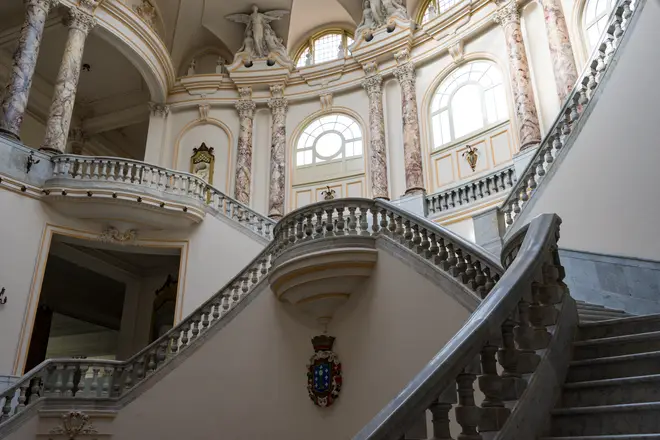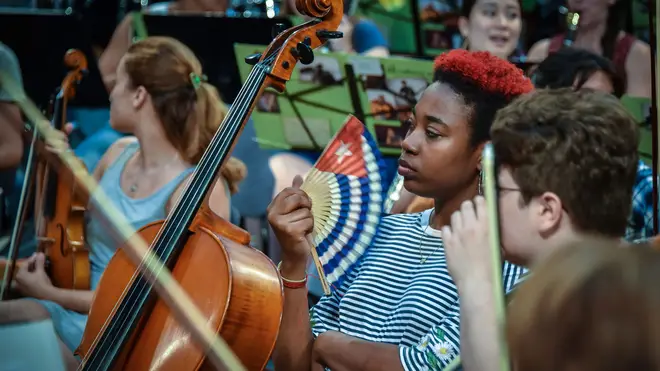On Air Now
Relaxing Evenings with Zeb Soanes 7pm - 10pm
28 July 2022, 17:15 | Updated: 28 July 2022, 18:32

Does music actually have the power to mend politically strained relationships? We ask the founder of the Cuban American Youth Orchestra...
From Ella Fitzgerald to Nadia Boulanger, famous musicians throughout history have praised music for its unique ability to bring people together.
Music, and the act of music-making, has long been cited as a way of transcending language, politics, race, faith, and other dividers that keep humanity apart from one another.
For 24-year-old Rodrigo García Ameneiro, the connective power of music is something he has witnessed first-hand. Ameneiro is a pianist from Havana, Cuba, who recently participated in a workshop with CAYO, the Cuban American Youth Orchestra, in May 2022.
CAYO was established in 2016, as a way to bring together musicians from Cuba and America, two countries with a historically strained relationship.
Despite their differences, Ameneiro told Classic FM that in his first rehearsal with the ensemble, “when we began to speak in the language of art, of music, the political barriers were immediately removed”.
But how and why? We delve into the origins of the Cuban American Youth Orchestra, and the history of bi-national orchestras who work to unite musicians from multiple nations through the power of music.
Read more: 30 hopeful pieces of classical music, as chosen by the nation’s leading youth orchestra

May 2022 Chamber Music Residency
The Cuban American Youth Orchestra (CAYO) was created by Dr Rena Kraut, a musician and educator living in Minneapolis.
While Dr Kraut admits the idea of bringing musicians from different nations together in an orchestra isn’t an original idea, “it was new for these two countries”.
“Cuba and America are neighbours. I mean Cuba is right there,” Dr Kraut gestured. “I was reading yesterday that someone was fleeing the police in Miami, Florida, and he was caught trying to jet ski to Cuba. That’s how close, geographically, our countries are.
“To have neighbours that close, it’s nonsense that we don’t have a relationship”.
CAYO was established as a non-profit in December 2016, and since its establishment musicians from America and Cuba have travelled to each others’ country on various tours.
In 2019, CAYO made the first large-scale artistic collaboration between the United States and Cuba, through an inaugural full orchestra tour. The ensemble was made up of approximately 40 American and 40 Cuban student musicians, all aged 18 to 24.

In 2022, CAYO held a chamber music residency involving four young musicians: two from the US, and two from Cuba.
Ameneiro was one of the two Cuban musicians. For the 24-year-old musician, CAYO represents “an exchange of communication and friendship”.
“The experience [of playing on a CAYO programme] was exceptional,” Ameneiro told Classic FM. “From the first day we had this good energy, and a desire to create together and learn from each other.
“The love that we express through our art, eliminates the barriers that separate our cultures”.
CAYO plans to return to Havana later this year in October 2022.

Dr Kraut plays clarinet as a freelancer with the Minnesota Orchestra, and has been working with the ensemble since 2004. And it was this orchestra that first brought Dr Kraut to the island country in 2015 on a musical tour.
“At the end of 2014, President Obama opened relations with Cuba,” Dr Kraut told Classic FM. “And so the Minnesota Orchestra just really jumped at the opportunity to travel there as a celebration of this new relationship that Obama was cultivating.”
While travel to Cuba for tourism remains prohibited by statute for Americans, Dr Kraut and the Minnesota Orchestra were able to fly out in 2015 with special federal approval, taking the first ever direct flight from Minneapolis to Havana.
It was the first time a US orchestra had performed in Cuba for over 15 years. The New York Times described the Minnesota Orchestra tour as “a symbol of the rapprochement between the United States and Cuba”.
On the opening night of their first concert, the orchestra performed the Cuban national anthem followed by ‘The Star Spangled Banner’, astonishing the crowd, many of whom had never met an American before.
“It was a really powerful experience,” Dr Kraut told Classic FM, “to feel like you’re a part of history, not only for the organisation, but also for the country.”
Read more: What are the lyrics to the US National Anthem, The Star-Spangled Banner?

On the trip itself, Dr Kraut found her visit to the island country “a total surprise in every way”.
Despite being excited to go, at first, this wasn’t for the music, but rather her affinity for Latin America and for Spanish speaking countries.
“I’ve always been really interested in working with young people”, Dr Kraut explained. “So for me to be experiencing this new culture when I travelled to Cuba, alongside the children, it was an instant addiction.
“And what I found there, is something you can find in a lot of places. When I sat down with these people who were from another culture, another place - that was where the magic happened.
“The great thing about this tour was they made time and space for the musicians to work with students and musicians we met down there, which is unusual.
“Usually when an orchestra tours, they just fly in, play a concert, and leave. But we wanted to have more of an impact than just a performance; we wanted to work and create together with the local communities.”
Read more: What is Cuba’s national anthem, who wrote it and what do the lyrics mean in English?

The Minnesota Orchestra worked with the Cuban National Youth Orchestra while they were in Havana, and this was the first time Dr Kraut, along with her orchestral colleagues had worked with young Cuban musicians.
“The first thing that struck all of us was that these young musicians were so hungry to learn,” Dr Kraut told Classic FM. “The clarinet section ended up staying late after one rehearsal, because the students were begging us to stay!
“Cuba is a very isolated place, not just because it's an island, but it’s politically very isolated. So this experience was new for them, and you could see they just wanted to work very hard.
“In America, young musicians can be wary when someone asks if they want to do a masterclass, but the students in Cuba just went for it. Some of their instruments were held together by string and duct tape, but they made no excuses.
“I thought, I have to get American students next to these young musicians, to be inspired by them to be fearless, to not think about their equipment, and to just play for the opportunity.”
Read more: The orchestra using a world stage to break stereotypes for female musicians in the middle east

CAYO isn’t the first time young American musicians have reached across borders to develop partnerships. A similar endeavour was founded in 1987, in the form of the American Russian Youth Orchestra (ARYO).
“Not by a musician,” Dr Kraut told Classic FM, “but by a diplomat, Edythe Holbrook. She had this idea to found this cultural diplomacy organisation for the explicit purpose of bringing young people together from warring nations.” Holbrook would go on to become a mentor to Dr Kraut in the establishment of CAYO, 28 years later.
The American Russian ensemble was created to be a philanthropic and diplomatic training orchestra open to instrumentalists, vocalists and conductors from the States and the former Soviet Union; the orchestra was originally named the American Soviet Youth Orchestra until the fall of the Union a few years later.
Made up of 80 of the best young musicians from the two countries, not only were instrumentalists from America getting to play with those from the Soviet Union, but due to travel restrictions within the country, those from different parts of the Union were also able to play together for the first time.
Read more: Why a leading Estonian conductor chose to stay in Russia after Ukraine invasion

Copland Fanfare for the Common Man/American Soviet Youth Orchestra
Whilst the ARYO was disbanded in the early 21st century, an orchestra founded on similar ideals toured across Russia and the UK in September 2019.
The Britten-Shostakovich Festival Orchestra, named after the friendship between the two notable composers, of English and Russian (Soviet era) nationality respectively, brought together 87 music students and recent conservatoire graduates from the UK and Russia.
Since the outbreak of the war in Ukraine, multiple arts organisations across the world have invited Russian and Ukrainian artists to perform on the same stage, a notable example of this being ‘Dance for Ukraine’, a performance which took place at the London Coliseum earlier this year.
Those familiar to the classical music world may also know of the West-Eastern Divan Orchestra, an ensemble founded by conductor, Daniel Barenboim, and Palestinian literary scholar Edward Said, which brings together young Israeli and Arab musicians.
Read more: ‘Dance for Ukraine’ – world's finest Ballet Principals come together in show of solidarity

Barenboim on the West-Eastern Divan Orchestra
With a global pandemic, and a backtrack on Cuban American relations during former President Donald Trump’s administration, CAYO has faced challenges getting musicians between the two countries.
Dr Kraut told Classic FM, “There’s been a little bit of movement from President Biden on lifting restrictions on travel between Cuba and America, and while we’ve been able to bring students to Cuba from America in the past, the one thing we haven’t yet managed to do is bring a whole orchestra worth of Cuban musicians over here.
“We’re still waiting for that day and that’s what we’re pitching next,” she explained, “we’ve only been able to bring students over to the states from Cuba if they Spanish passport.
“So if President Biden is listening, that’s what needs to change. We need the embassy to start issuing visas. Because it’s absolutely necessary that we have an equal exchange on both sides of the water and Cuban music students involved in CAYO can have exposure to our country, as well as Americans having exposure to theirs.”
Read more: Yo-Yo Ma plays poignant ‘Amazing Grace’ at President Biden’s inauguration concert

CAYO Mini-documentary
So is musical diplomacy an integral part of future global relations? Well, Dr Kraut certainly alludes to this.
“Our tagline has become the ‘world is a better place when you know your neighbours’,” she explained. “And playing music together fast forwards that relationship.
“When you’re sitting next to someone and you start playing the same piece, you start to understand each other much quicker.
“Playing together is the ultimate teamwork. It’s the ultimate diplomacy; there’s negotiation, and then the most important part of any relationship, you have to listen to each other. Everyone in an orchestra needs to have a platform to make their voice heard.
“At the end of the day, people can create these strengthened relationships through multiple ways, but I’ve been swimming in the waters of music since I was three, so for me – and many others – this is the most powerful way to achieve global understanding.”